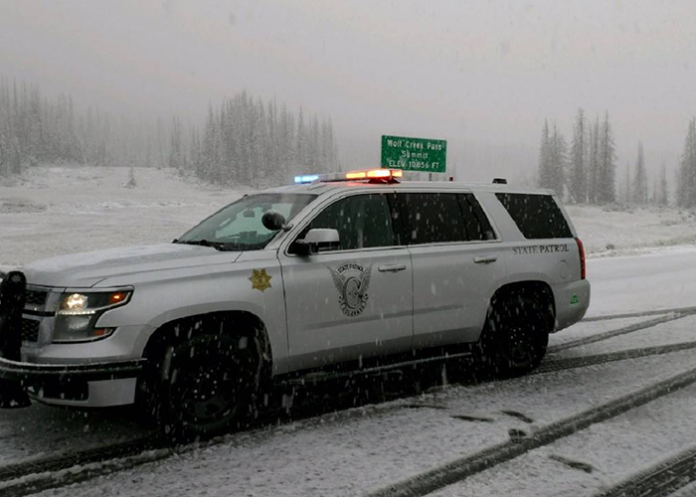Colorado transportation officials are going to be conducting safety checks along one of the state’s most treacherous mountain passes in an attempt to prevent crashes.
CMV “Safety Checks” Ahead
During October, the Colorado Department of Transportation (CDOT) and the Colorado State Patrol are joining forces to conduct CMV safety checks at the summit of US Highway 160 Wolf Creek Pass.

During the safety checks, troopers will be interviewing truck drivers, informing them of the locations of tight turns on the pass, and educating them about the importance of downshifting and maintaining a low speed for the next 7 miles.
“The number of crashes over the years underscores the need to slow down over this mountain pass,” said Colorado State Patrol Capt. Adrian Driscoll. “From 2015 to 2019, there have been 47 semi-truck crashes on the west side of Wolf Creek Pass. Three of those crashes resulted in needless fatalities.”
One of the most recent fatalities occurred in May 2018. A 30 year old Florida-based truck driver lost his life on Wolf Creek Pass after he was unable to negotiate the turn at mile marker 160, drove through the scenic overlook parking lot, and crashed off of a cliff, falling approximately 125 feet before coming to a stop.
“Stopping CMVs and talking with drivers has proven successful,” added Driscoll. “Past safety checks have coincided with construction projects on the pass. Letting drivers know what they are in for, coming down the pass can prevent a potential crash, so we’re going to pick those efforts up again.”
Wolf Creek Pass 101
What is the speed limit?
*The posted speed limit for traffic traveling westbound, downhill from the summit varies from 25 to 45 MPH. Commercial trucks must maintain the lower 25 MPH speed.
What is the grade of the pass?
*The west side of the pass is at a 7% downhill grade.
What is the distance from the summit to the west base?
*The distance from the summit (near Wolf Creek Ski Area) to the west base of the pass (near Treasure Falls) is just over eight miles.
What curves will drivers encounter?
*A dangerous hairpin curve is located six and a half miles from the summit of Wolf Creek Pass.
Are there public access areas on the pass route?
*A ski area, forest roads and a public scenic lookout are all points of access along US 160 Wolf Creek Pass in which truckers may encounter other vehicles attempting to enter or exit the roadway.
Where are brake stations, chain-up stations and runaway ramps located?
*Truck drivers should inspect their brakes at the summit, before descending the eight mile trip down the pass. A wide shoulder area is available to all motorists traveling both west and eastbound. This area can also be used as a chain-up station.
*Two runaway escape ramps are available for out-of-control trucks at mile points (MP) 162.5 and 161. (see runaway ramps details below)
Other southwest/south-central Colorado passes include: US 550 Red Mountain, Molas and Coal Bank Passes; Colorado Highway (CO) 145 Lizard Head Pass; CO 17 La Manga-Cumbres Pass; and US 50 Monarch Pass.
MAINTAIN CONTROL: Even the most experienced drivers should practice the utmost caution and safe driving practices to keep control of their vehicles.
- Check brakes before descending the pass.
- Maintain a low speed, in low gear. Use flashers to warn other vehicles of the truck’s low speed.
- Do not “ride” the truck’s brakes. This will cause overheating and possible loss of the brake system.
- Jake Brakes (or compression brakes) can be a useful braking mechanism to help control the speed of a heavy truck. However, the best practice is to remain in low gears to avoid overheating.
- Keep brakes cool by pulling into brake stations or onto the shoulder of the road, if a safe spot can be located.
RUNAWAY RAMPS: Two runaway ramps are located on the west side of Wolf Creek Pass for trucks traveling downhill and westbound. These emergency escape ramps are located on the right side of the road and preceded by warning signs at each location. Both are incline ramps.
- Runaway Ramp, MP 162.5 – approximately 4.5 miles from the pass summit.
- Runaway Ramp, MP 161 – approximately 6 miles from the pass summit. This location is a trucker’s last chance to make a decision to use the ramp.
If drivers are forced to use a runaway ramp:
- Maneuver the trucks into the far right lane before approaching upgrade ramps.
- As the truck approaches the runaway ramp, steer straight and try to keep the wheels aligned.
- Ramps are narrow. Attempt to stay in the center of the ramp to avoid any risk of rolling over.
- Once the truck is stopped, call 911 to report the incident, even if there are no injuries associated with the episode.
NEVER HESITATE: “If a truck driver has lost control, there should never be a hesitation to use the runaway ramps,” Capt. Driscoll emphasized. “If a truck’s brakes fail due to overheating or excessive use going downhill, runaway ramps are the only way the truck will be able to stop.”
